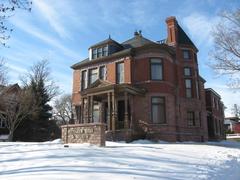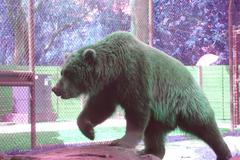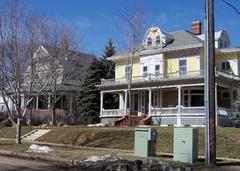Gitchie Manitou State Preserve Visiting Hours and Tickets
Date: 17/08/2024
Introduction
Gitchie Manitou State Preserve, nestled in Lyon County, Iowa, near Sioux Falls, South Dakota, is a treasure trove of natural beauty, historical significance, and cultural heritage. The name ‘Gitchie Manitou,’ derived from the Dakota Sioux language, translates to ‘Great Spirit,’ reflecting the site’s spiritual importance to various Native American tribes, including the Dakota, Lakota, and Nakota Sioux. This preserve is renowned for its ancient quartzite formations, dating back approximately 1.6 billion years, making them some of the oldest exposed bedrock in the United States. Beyond its geological marvels, Gitchie Manitou has a rich tapestry of prehistoric and indigenous history, marked by archaeological discoveries such as petroglyphs, projectile points, and pottery shards that offer insights into early human activity in the region. The site also bears the scars of European settlement and conflict, encapsulating the tumultuous history of forced removal and assimilation policies that disrupted indigenous connections to sacred lands (Des Moines Register, Wikipedia, Notes on Iowa). This guide aims to provide a comprehensive overview of Gitchie Manitou State Preserve, offering valuable information for visitors, from historical insights to practical travel tips, ensuring an enriching experience at this unique and poignant site.
Table of Contents
- Introduction
- Prehistoric and Indigenous Significance
- Archaeological Discoveries
- European Settlement and Conflict
- The Gitchie Manitou Murders
- Preservation and Modern Significance
- Visitor Information
- Visitor Tips for Exploring Historical Sites
- FAQ
- Conclusion and Call to Action
Explore the Historical Significance of Gitchie Manitou State Preserve: Visiting Hours, Tickets, and Tips
Introduction
Gitchie Manitou State Preserve, located in Lyon County, Iowa, near Sioux Falls, South Dakota, is a site of immense historical and cultural significance. From ancient geological formations to rich indigenous history, this preserve offers a unique glimpse into the past. This article provides an overview of Gitchie Manitou’s historical importance, visitor information, and tips for an enriching experience.
Prehistoric and Indigenous Significance
Gitchie Manitou is home to some of the oldest exposed bedrock in the United States, dating back approximately 1.6 billion years. The Dakota Sioux term “Gitchie Manitou,” meaning “Great Spirit,” reflects its spiritual importance to Native American tribes such as the Dakota, Lakota, and Nakota Sioux. These tribes used the area for ceremonial purposes, believing the quartzite outcrops were imbued with spiritual energy.
Archaeological Discoveries
Archaeological excavations have uncovered artifacts like projectile points, pottery shards, and tools, indicating human activity dating back thousands of years. Ancient petroglyphs etched into the quartzite rock formations depict various symbols and figures, offering insights into the spiritual beliefs and artistic expressions of the region’s early inhabitants.
European Settlement and Conflict
The 19th-century arrival of European settlers brought significant changes and conflicts to the region. The U.S. government’s forced removal and assimilation policies displaced many indigenous tribes, disrupting their connection to sacred sites like Gitchie Manitou. Despite these challenges, the site’s cultural significance endured, leading to its designation as a state preserve in 1969 to protect its natural and cultural heritage.
The Gitchie Manitou Murders
In 1973, four teenagers were brutally murdered at the preserve, an event known as the Gitchie Manitou Murders. This tragic incident shocked the local community and brought national attention to the area. Efforts to commemorate the victims and educate visitors about the tragedy have been undertaken to honor their memory and the lessons of the past.
Preservation and Modern Significance
Today, Gitchie Manitou is recognized for its natural beauty and rich historical heritage. Initiatives to preserve the site’s ecological integrity and cultural significance are ongoing. Interpretive trails, educational programs, and guided tours provide opportunities to learn about the preserve’s history and importance to indigenous peoples and early settlers. The site’s designation as a National Natural Landmark in 1980 ensures its protection for future generations.
Visitor Information
- Visiting Hours: Gitchie Manitou State Preserve is open daily from dawn to dusk.
- Tickets: Admission to the preserve is free of charge.
- Travel Tips: The preserve is accessible by car, with parking available at the entrance. Visitors are encouraged to bring water, wear comfortable shoes, and prepare for varying weather conditions.
- Nearby Attractions: Sioux Falls offers additional historical sites, parks, and cultural attractions worth exploring.
- Accessibility: Some trails may be challenging for visitors with mobility issues. It’s advisable to check with the preserve’s visitor center for more information.
Visitor Tips for Exploring Historical Sites
- Respect the Land: Recognize the cultural and spiritual significance of the preserve to indigenous peoples. Avoid disturbing or defacing the petroglyphs and other archaeological sites.
- Stay on Designated Trails: To protect the natural and historical features, stick to marked trails and avoid venturing off-path.
- Educational Resources: Take advantage of the interpretive signs and educational materials available to learn about the preserve’s history and significance.
- Guided Tours: Consider joining a guided tour to gain deeper insights into the preserve’s historical and cultural context from knowledgeable guides.
- Leave No Trace: Practice Leave No Trace principles by packing out all trash, minimizing your impact on the environment, and respecting wildlife.
FAQ
-
What are the visiting hours for Gitchie Manitou State Preserve?
- The preserve is open daily from dawn to dusk.
-
Is there an admission fee?
- No, admission to the preserve is free of charge.
-
Are there guided tours available?
- Yes, guided tours are available and provide valuable insights into the preserve’s history and significance.
-
What should I bring when visiting?
- Visitors are encouraged to bring water, wear comfortable shoes, and prepare for varying weather conditions.
Conclusion and Call to Action
Gitchie Manitou State Preserve offers a unique opportunity to explore a site of profound historical and cultural significance. By following the visitor tips and respecting the land, you can help preserve this important site for future generations. For more information and updates, consider downloading the mobile app Audiala or following us on social media. Plan your visit today and immerse yourself in the rich history and natural beauty of Gitchie Manitou.
Conclusion
Gitchie Manitou State Preserve stands as a testament to the rich tapestry of history, culture, and natural beauty that defines this region. From its ancient quartzite formations and vibrant native flora to its deep-rooted indigenous heritage and poignant historical narratives, the preserve offers a multifaceted experience for visitors. The tragic events of the 1973 Gitchie Manitou murders remind us of the site’s layered and often painful history, underscoring the importance of preserving and respecting this sacred ground. Whether you are a history enthusiast, nature lover, or simply seeking a peaceful retreat, Gitchie Manitou provides a unique opportunity to connect with the past and appreciate the natural world. By following the visitor tips and guidelines, you can help ensure that this significant site remains protected for future generations. Plan your visit today to explore the wonders of Gitchie Manitou State Preserve and immerse yourself in its profound historical and cultural significance (Des Moines Register, Wikipedia, Notes on Iowa, Argus Leader).
References
- Des Moines Register, 2023, Author source url
- Wikipedia, 2023, Author source url
- Notes on Iowa, 2023, Author source url
- Argus Leader, 2021, Author source url



